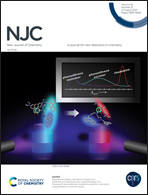Fluorogenic naked eye “turn-on” sensing of hypochlorous acid by a Zr-based metal organic framework†
Abstract
Hypochlorous acid (HOCl) is involved in several physiological and pathological functions. Hence, sensitive and accurate detection of HOCl is much needed. We report herein a new (dimethylthiocarbamoyl)oxy functionalized aqua stable Zr-UiO-66 MOF for the specific fluorogenic recognition of HOCl in a pure aqueous medium. The activated material (1′) exhibited a dramatic increase in emission intensity (∼46-fold) in the presence of HOCl. More importantly, the material has remarkable selectivity towards HOCl over other reactive oxygen species (ROS) and reactive nitrogen species (RNS). The “turn-on” nature of the material after the inclusion of HOCl could be detected by the naked eye under a UV lamp. Furthermore, a linear steady increase was observed with the gradual addition of HOCl solution over a wide linear range of 0–28 μM and the estimated LOD value was found to be 1.22 μM. HOCl-mediated oxidative cleavage of the pendant from the (dimethylthiocarbamoyl)oxy functionality to the hydroxyl functionality is the main reason behind the dramatic fluorescence enhancement of the present compound. The present compound is the first ever MOF based detector for the “turn-on” sensing of HOCl.



 Please wait while we load your content...
Please wait while we load your content...